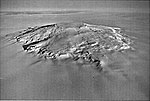Million years ago, abbreviated as Mya, Myr (megayear) or Ma (megaannum), is a unit of time equal to 1,000,000 years (i.e. 1×106 years), or approximately...
3 KB (372 words) - 23:12, 24 May 2024
"Million Years Ago" is a song recorded by English singer-songwriter Adele for her third studio album, 25 (2015). The song was written by Adele and Greg...
14 KB (1,147 words) - 21:21, 27 June 2024
Miocene (redirect from 13 million years ago)
epoch of the Neogene Period and extends from about 23.03 to 5.333 million years ago (Ma). The Miocene was named by Scottish geologist Charles Lyell; the...
94 KB (9,850 words) - 01:53, 15 July 2024
Pliocene (redirect from 2.4 million years ago)
epoch in the geologic time scale that extends from 5.333 million to 2.58 million years ago. It is the second and most recent epoch of the Neogene Period...
53 KB (5,770 words) - 21:57, 15 July 2024
paleontology, and genetics. Primates diverged from other mammals about 85 million years ago (mya), in the Late Cretaceous period, with their earliest fossils...
253 KB (26,386 words) - 20:09, 10 July 2024
dinosaurs became extinct 66 million years ago, and modern humans (Homo sapiens) did not exist until about 300,000 years B.C. Ray Harryhausen, who animated...
35 KB (3,684 words) - 02:00, 10 July 2024
Danian (redirect from 65.5 million years ago)
Priabonian Rupelian Chattian Aquitanian Subdivision of the Paleogene according to the ICS, as of 2021. Vertical axis scale: millions of years ago...
14 KB (1,387 words) - 18:59, 19 March 2024
Year (redirect from Giga-years ago)
convention among geoscientists to use "a" specifically for "years ago" (e.g. 1 Ma for 1 million years ago), and "y" or "yr" for a one-year time period. However...
51 KB (5,661 words) - 19:52, 14 July 2024
Quaternary period, from 2.5 million years ago to the present. Radiometric dating has yielded ages of up to 300,000 years for its rocks, and it reached...
53 KB (5,485 words) - 17:20, 11 May 2024
have been found from as early as the Cambrian explosion over 539 million years ago. Of the more than 81,000 living species of chordates, about half are...
53 KB (4,904 words) - 00:11, 3 July 2024
to have diverged around 5.7-11 million years ago during the Late Miocene. Homo erectus appeared about 2 million years ago and spread throughout Africa (where...
92 KB (7,978 words) - 02:13, 10 July 2024
during the Devonian period (400 million years ago). Another peak occurred in the Triassic period (220–200 million years ago). Since the start of the Industrial...
75 KB (10,657 words) - 05:50, 12 July 2024
from the late Miocene epoch (from around 6.2 million years ago) into the Holocene about 4,000 years ago, and various species existed in Africa, Europe...
48 KB (5,051 words) - 21:41, 14 July 2024
3 million years ago (which created the Henry's Fork Caldera and the Mesa Falls Tuff), and the Lava Creek eruption approximately 640,000 years ago (which...
38 KB (3,875 words) - 20:28, 27 May 2024
Bya (redirect from Billion years ago)
long scale to the short scale. Related units are mya ("million years ago"), and byr ("billion years"). These are traditionally written in lowercase. Ga or...
2 KB (198 words) - 04:02, 24 April 2024
the Earth, and mankind in one table. Each row is defined in years ago, that is, years before the present date, with the earliest times at the top of...
237 KB (6,444 words) - 20:33, 14 July 2024
Cretaceous–Paleogene extinction event (redirect from 66 million years ago)
three-quarters of the plant and animal species on Earth, approximately 66 million years ago. The event caused the extinction of all non-avian dinosaurs. Most...
170 KB (18,680 words) - 11:49, 14 July 2024
in Oceania that subsided after breaking away from Gondwana 83–79 million years ago. It has been described variously as a submerged continent, continental...
18 KB (2,900 words) - 23:47, 5 July 2024
around 3.5 million years ago, and Megantereon about 3 million years ago. Smilodon lived in North and South America from about 2.5 million years ago. This subfamily...
49 KB (3,902 words) - 08:37, 12 July 2024
the North American Plate (older than 539 million years), Jurassic aged limestone (201.3-145 million years ago), as well as island arc deposits and oceanic...
30 KB (2,664 words) - 05:18, 14 July 2024
billion years ago to 539 million years ago) basement rocks, with the oldest zircon dated 4.1 billion years ago and the oldest rock dated 3.8 billion years ago...
109 KB (8,690 words) - 16:41, 6 July 2024
a genus of dolichoderine ants thought to have gone extinct 15–20 million years ago was found in Paraguay, Brazil, and Argentina and redescribed in 2006...
49 KB (5,692 words) - 18:52, 15 July 2024
diverged some 70 million years ago. New World monkeys and catarrhine monkeys emerged within the simians roughly 35 million years ago. Old World monkeys...
49 KB (4,529 words) - 08:44, 5 June 2024
extends from the earliest known use of stone tools by hominins, c. 3.3 million years ago, to the end of the Pleistocene, c. 11,650 cal BP. The Paleolithic...
107 KB (11,381 words) - 00:36, 6 July 2024
Zanclean deluge is theorized to have refilled the Mediterranean Sea 5.33 million years ago. This flooding ended the Messinian salinity crisis and reconnected...
33 KB (3,751 words) - 21:07, 11 July 2024
Earth's geologic time scale, covering the time period from 538.8 million years ago to the present. It is the eon during which abundant animal and plant...
61 KB (6,168 words) - 08:22, 14 July 2024
600 to 540 million years ago, then finally Pangaea, which broke apart 200 million years ago. The present pattern of ice ages began about 40 million years ago, then...
49 KB (5,884 words) - 22:52, 8 July 2024
site was dated to c. 1.4 million years ago, but further research has fixed its chronological context to 1.5–1.2 million years ago. The site yielded stone...
23 KB (2,592 words) - 08:27, 17 April 2024
living species in the order Ginkgoales, which first appeared over 290 million years ago, and fossils very similar to the living species, belonging to the...
65 KB (6,996 words) - 12:21, 1 July 2024
during the Carboniferous approximately 335 million years ago, and began to break apart about 200 million years ago, at the end of the Triassic and beginning...
39 KB (4,697 words) - 07:36, 13 May 2024





















